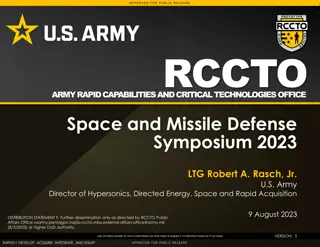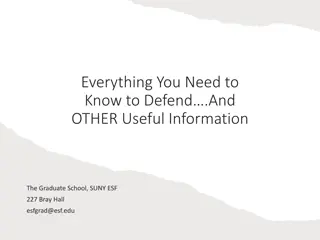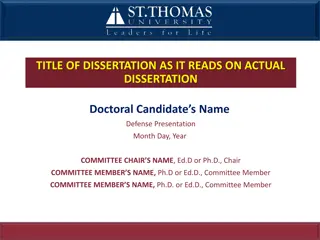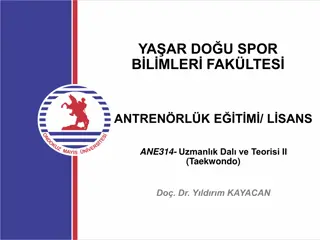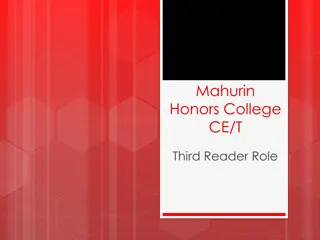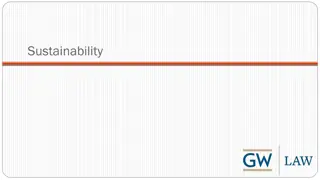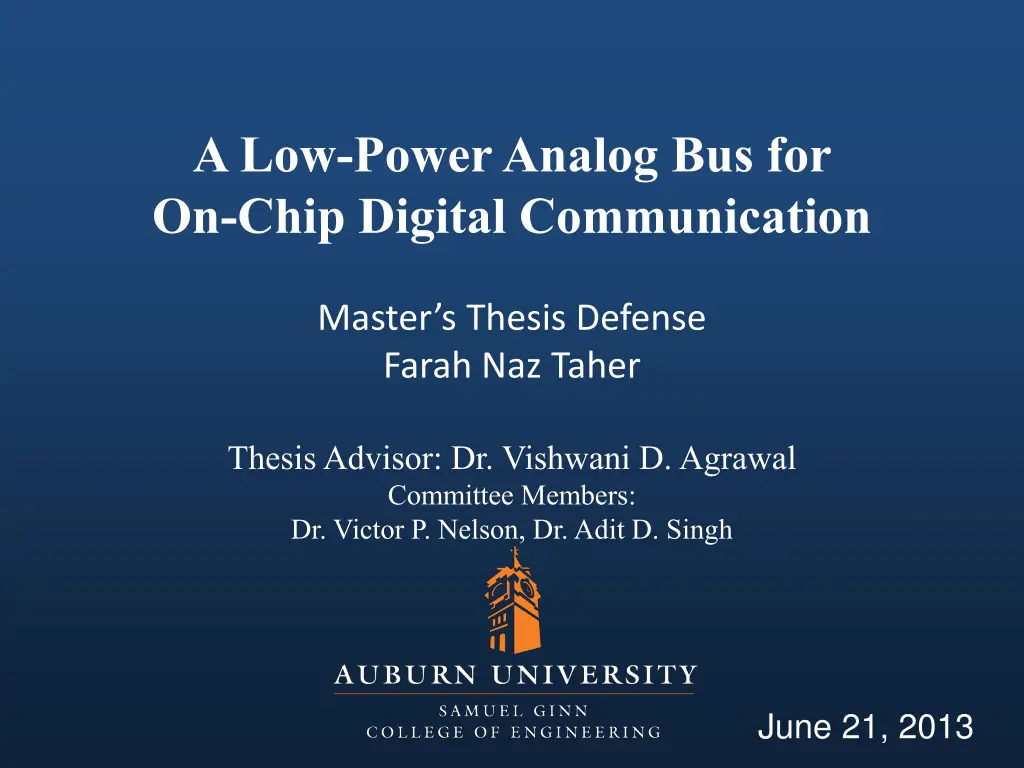
Low-Power Analog Bus for On-Chip Communication
Explore a low-power analog bus designed for on-chip digital communication, addressing issues with traditional parallel buses such as power dissipation, routing complexity, and signal integrity. The motivation behind the study is driven by the need for efficient on-chip communication amidst increasing transistor density and performance demands.
Download Presentation

Please find below an Image/Link to download the presentation.
The content on the website is provided AS IS for your information and personal use only. It may not be sold, licensed, or shared on other websites without obtaining consent from the author. If you encounter any issues during the download, it is possible that the publisher has removed the file from their server.
You are allowed to download the files provided on this website for personal or commercial use, subject to the condition that they are used lawfully. All files are the property of their respective owners.
The content on the website is provided AS IS for your information and personal use only. It may not be sold, licensed, or shared on other websites without obtaining consent from the author.
E N D
Presentation Transcript
A Low-Power Analog Bus for On-Chip Digital Communication Master s Thesis Defense Farah Naz Taher Thesis Advisor: Dr. Vishwani D. Agrawal Committee Members: Dr. Victor P. Nelson, Dr. Adit D. Singh June 21, 2013
Outline Motivation Background Problem Statement Concept Result Future Work Reference 2 Farah Naz Taher
Motivation Power Performance Area Testability 3 Farah Naz Taher
Motivation Moore s Law: Empirical observation that component density and performance of integrated circuits doubles every year G. E. Moore, 1965 S. E. Thompson et. al., Materials Today 2006. 4 Farah Naz Taher
Motivation Pollack's Rule: Each technology generation doubles the number of transistor on a chip which enables that performance increase is roughly proportional to square root of increase in complexity. S. Borkar, DAC 2007 5 Farah Naz Taher
Motivation More Transistors More Blocks More Cores More on-chip Communication More Power 6 Farah Naz Taher
Outline Motivation Background Problem Statement Concept Result Future Work Reference 7 Farah Naz Taher
Bus Structure A bus is a collection of signals (wires) that connects one or more IP components for the purpose of data communication. 8 Farah Naz Taher
Issues With Parallel Bus Power Dissipation Routing Complexity Area Signal Integrity and Crosstalk Performance 9 Farah Naz Taher
Dynamic Power For low swing signaling: Average dynamic power for a single wire: Weste and Harris, 2010 10 Farah Naz Taher
Dynamic Power If there are n-lines in the bus with similar activity, then the total power consumed by such a bus will be n-times that of a single bit line Weste and Harris, 2010 11 Farah Naz Taher
Dynamic Power Analysis shows that interconnect power can be over 50% of the dynamic power; over 90% of the interconnect power is consumed by only 10% of the interconnections Weste and Harris, 2010 12 Farah Naz Taher
The SerDes Option SerDes is a widely used technique for replacing multiple-lines on-chip bus with a single on-chip line to achieve high speed serial communication. In serial bus architecture, n parallel data bits are serialized at the transmitter side. The data transfer takes place at a speed which is n times higher than the data rate of the parallel data. At the receiver side, the data has to be de-serialized to reproduce the n-bit parallel word. A. Kedia et. al., ISCAS 2007 N. Hatta et. al. ISPJ 2006 13 Farah Naz Taher
Disadvantages of SerDes Increase in the number of transitions n times faster frequency More Power Consumption Encoding scheme needs to be employed to reduce power consumption. Some proposed methods are: Silent: Low energy transmission LOUD: Bit ordering 14 Farah Naz Taher
Outline Motivation Background Problem Statement Concept Result Future Work Reference 15 Farah Naz Taher
Problem Statement The objective of this work is to develop a low power analog bus for on-chip communication to replace existing parallel digital bus. 16 Farah Naz Taher
Outline Motivation Background Problem Statement Concept Result Future Work Reference 17 Farah Naz Taher
Analog Bus Replace n wires of an n-bit digital bus carrying data between cores with just one (or few) wire(s) carrying analog signal(s) encoded into 2n levels of voltage Analog bus uses digital-to-analog converter (DAC) drivers and analog-to-digital converter (ADC) receivers. 18 Farah Naz Taher
Parallel Bus vs. Analog Bus 19 Farah Naz Taher
Parallel bus vs. Analog Bus 20 Farah Naz Taher
Analog Bus Parallel Bus Digital Data (Volt) 1 0 1 0 0 1 0 0 1 1 0 1 1 0 0 0 1 0 0 0 0 1 1 0 0 1 1 0 1 1 0 0 1 0 1 0 0 1 0 1 0 0 0 1 0 0 1 1 1 1 0 0 1 0 0 0 1 1 0 0 1 1 0 0 Converted Analog Bus (Volt) 1.00 0.067 0.67 0.00 0.067 0.933 0.267 0.133 0.600 0.867 0.267 0.67 0.867 0.333 0.133 0.133 21 Farah Naz Taher
Vswing 22 Farah Naz Taher
Vswing Total number of possible variations Total possible voltage swing Average Voltage swing 23 Farah Naz Taher
Proposition The analog bus can be used in cases where: i. Power consumed by analog bus architecture < Power consumed by parallel bus ii. The signal can be reproduced without any error The choice of resolution for substituting the number of lines in digital buses with proposed analog bus depends on two criteria. i. Power consumed by the ADC and DAC ii. Noise margin of signal line 24 Farah Naz Taher
Proposition The analog bus can be used in cases where: i. Power consumed by analog bus architecture < Power consumed by parallel bus ii. The signal can be reproduced without any error The choice of resolution for substituting the number of lines in digital buses with proposed analog bus depends on two criteria: i. Power consumed by the ADC and DAC ii. Noise margin of signal line 25 Farah Naz Taher
Proposition Corollary 1: Analog bus is effective only if the power consumed by the analog bus architecture is less than the power consumption of the digital bus. Corollary 2: To reproduce the signal in the digital bus without any error, the noise level should be less than half of the resolution of the ADC. 26 Farah Naz Taher
Proposition Corollary 1: Analog bus is effective only if the power consumed by the analog bus architecture is less than the power consumption of the digital bus. Corollary 2: To reproduce the signal in the digital bus without any error, the noise level should be less than half of the resolution of the ADC. 27 Farah Naz Taher
Advantages Less Number of wires Power Saving Lower Capacitance Lower Voltage Swing 28 Farah Naz Taher
Advantages Power Wire Area Crosstalk Potential Savings Multiple Drivers/ Buffers Routing Complexity 29 Farah Naz Taher
Outline Motivation Background Problem Statement Concept Experimental Result Future Work Reference 30 Farah Naz Taher
Experimental Setup ITRS Interconnect Roadmap 2012 LTspice IV (Version 4.18b) Baker 2008 31 Farah Naz Taher
Replacement of 4-Line Parallel Bus 32 Farah Naz Taher
Replacement of 4-Line Parallel Bus Digital Data: Bus Input Analog Data: Simulated DAC Output 33 Farah Naz Taher
Replacement of 4-line Parallel Bus Bus width = 4, Frequency = 1GHz 34 Farah Naz Taher
Replacement of 4-line Parallel Bus Bus width = 4, Frequency = 1GHz 2500 2000 Power Consumption ( W) 1500 Parallel Bus 1000 Analog Bus 500 0 1mm 2mm 3mm 4mm 5mm Bus Length 35 Farah Naz Taher
Replacement of 4-line Parallel Bus Bus width = 4, Frequency = 500MHz 36 Farah Naz Taher
Replacement of 4-line Parallel Bus Bus width = 4, Frequency = 500MHz 2500 2000 Power Consumption ( W) 1500 Parallel Bus 1000 Analog Bus 500 0 1mm 2mm 3mm 4mm 5mm Bus Length 37 Farah Naz Taher
Replacement of 8-Line Parallel Bus 38 Farah Naz Taher
Replacement of 8-Line Parallel Bus Digital Data Analog Data 39 Farah Naz Taher
Replacement of 8-Line Parallel Bus Bus width = 8, Frequency = 500MHz 40 Farah Naz Taher
Replacement of 8-Line Parallel Bus Bus width = 8, Frequency = 500MHz 2500 2000 Power Consumption( W) 1500 Parallel Bus 1000 Analog Bus 500 0 1mm 2mm 3mm 4mm 5mm Bus Length 41 Farah Naz Taher
Analysis for f = 500MHz 42 Farah Naz Taher
Analysis Bus Width: 4, Frequency: 500MHz, Length = 1mm The average power consumption per mm for the analog bus is around 16.17 W. The average power consumption for a 4-bit bus is 219 W. Bus Width: 8, Frequency: 500MHz, Length = 1mm The average power consumption per mm for the analog bus is around 18.3 W. The average power consumption for an 8-bit bus is 469.2 W. 43 Farah Naz Taher
Analysis The power consumption in the parallel bus has an exponential increase with respect to the bus length whereas the power consumption in the analog bus increases slowly. SPICE simulation for an ideal case shows that, the ratio of bus power consumed by the proposed analog scheme to a typical parallel digital scheme is given by Panalog/Pdigital = 1/(3n). 44 Farah Naz Taher
Analysis The power consumption of the ADC/DAC can be a design challenge for analog bus. ADC/DAC with a power consumption in W range exists already. Example: ADC (ADS7924 from Texas Instruments): 5.5 W DAC (LTC1591 from Linear technology): 10 W In the 4-Bit and 8-Bit cases we have available power margins of 200 W and 450 W, respectively. The analog bus architecture will save power even after addition of 15.5 W power consuming elements. 45 Farah Naz Taher
Outline Motivation Background Problem Statement Concept Experimental Result Future Work Reference 46 Farah Naz Taher
Future Work This thesis examined the feasibility of the scheme, much work remains to be done Design Suitable Converters Design Encoding Scheme Analyze the Scheme in Digital Testing Fabricate the System on a Chip 47 Farah Naz Taher
Outline Motivation Background Problem Statement Concept Experimental Result Future Work Reference 48 Farah Naz Taher
Reference 14-Bit and 16-Bit Parallel Low Glitch Multiplying DACs with 4-Quadrant Resistors, White Paper, Linear Technology Corporation, Feb. 1999. http://cds.linear.com/docs/en/datasheet/15917fa.pdf. 2.2V, 12-Bit, 4-Channel, microPOWER Analog-to-Digital converter With I2C Interface, White Paper, Texas Instruments Incorporated, Jan. 2012. http://www.ti.com/lit/ds/symlink/ads7924.pdf. LTspice IV (Version 4.18b)," 2013. Linear Technology Corporation, http://www.com/designtools/software/#LTspice. R. J. Baker, CMOS Mixed-signal Circuit Design. John Wiley & Sons, 2008. S. Borkar, Thousand Core Chips: A Technology Perspective," in Proc. 44th Design Automation Conference, 2007, pp. 746-749. N. Hatta, N. D. Barli, C. Iwama, L. D. Hung, D. Tashiro, S. Sakai, and H. Tanaka, Bus Serialization for Reducing Power Consumption," ISPJ Trans. Advanced Computing Systems, vol. 47, no. SIG-3, pp. 686-694, Mar. 2006. A. Kedia and R. Saleh, Power Reduction of On-Chip Serial Links," in IEEE International Symp. Circuits and Systems, 2007, pp. 865-868. B. Li, V. D. Agrawal, and B. Zhang, Mixed-Signal Compression of Digital Test Data. Personal Communication, June 2013. G. E. Moore, Cramming More Components onto Integrated Circuits," Electronics. Vol. 38, no. 8, Apr. 1965. Semiconductor Industry Association, International Technology Roadmap for Semiconductors, 2012. http://www.itrs.net/Links/2012ITRS/Home2012.htm. F. N. Taher and V. D. Agrawal, A Low-Power Analog Bus Approach for On-Chip Digital Communication," 31st IEEE International Conf. Computer Design, 2013. Submitted F. N. Taher, S. Sindia, and V. D. Agrawal, An Analog Bus for Low Power On-Chip Digital Communication," in Work- in-Progress Poster Session, Design Automation Conference, (Austin, Texas), June 2013. 49 Farah Naz Taher

